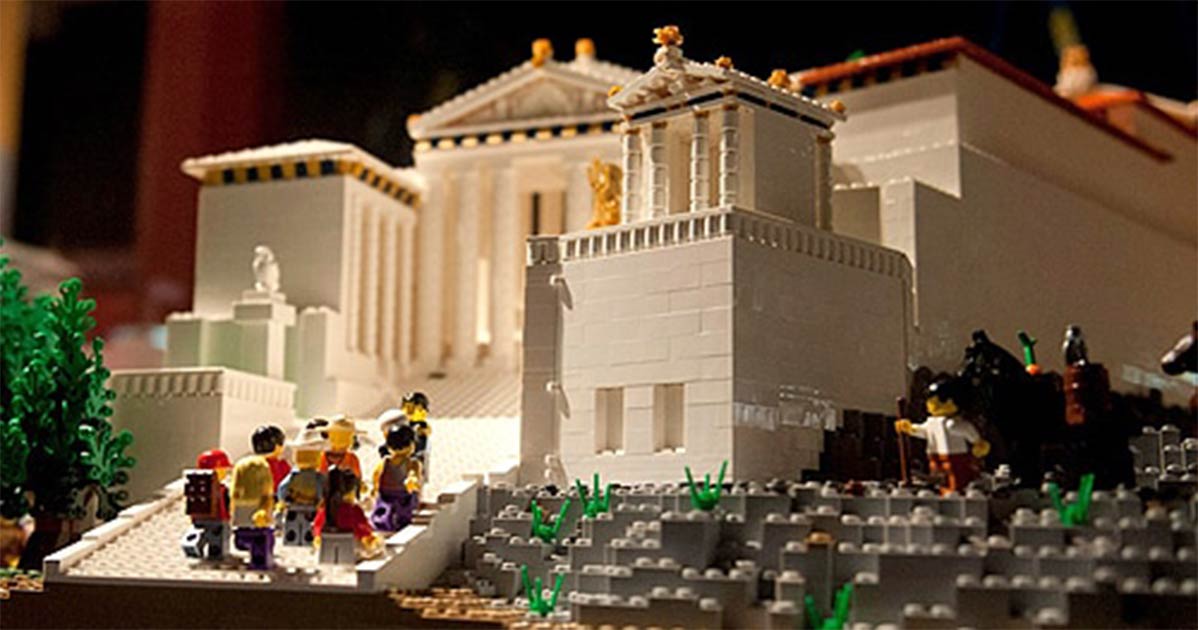Lego Acropolis Proves Just as Popular as the Real Thing
A certified professional Lego designer? Yes, there is such a thing! A Lego expert recreated a Lego Acropolis, complete with the Parthenon. And, believe it or not, the Lego Acropolis even has a tiny Lego Lord Elgin stealing the famous “Elgin” marble statues. The Lego Acropolis was given to the biggest historical museum in Greece, partially to attract more “young people.”
Construction of the Greek Parthenon began at the Athenian Acropolis in 447 BC and the immense temple was completed in 438 BC. Dedicated to the patron goddess of Athens, Athena, the Parthenon and its sculptures were created at the height of Classical Greece and the building is an icon of the formative days of Western civilization.
In 1975, the Greek government began restoring the Parthenon and hundreds of fragile sculptures were transferred to the Parthenon Gallery at the Acropolis Museum. A custom-made crane was installed for moving the huge blocks of marble that were discovered to have been held together by elongated iron H’pins coated in lead, to protect them from corrosion.
Ryan McNaught, the only certified professional Lego designer in Australia, recreated the Parthenon using more than 120,000 Lego bricks. The Lego Acropolis was on public display in Australia for a couple of years before being generously gifted by McNaught to Athens’ Acropolis Museum in Greece, where it has become a central exhibit.

This is what the Parthenon on the Acropolis in Athens, Greece looks like in real life. (TTstudio / Adobe Stock)
The Lego Acropolis And The Real Acropolis
In 2008, Evan Hadingham, senior science editor of NOVA published the article “ Unlocking the Mysteries of the Parthenon,” in Smithsonian Magazine. The author explained that the Parthenon builders had coated the H’pins, which connected the huge stone blocks, with lead to prevent corrosion. However, the 19th-century stabilizing pins “were not so coated” and cracked the marble. But this wasn’t something that Lego designer Ryan McNaught had to worry about as he pressed, clicked and moved on to the next brick in his miniature Lego Acropolis.
The Lego Acropolis features the legendary Propylaea gateway leading to the Parthenon, the Temple of Athena Nike, and the Old Temple of Athena. And bringing the ancient scene to life are little Lego Greek figures like Theseus in the labyrinth with the Minotaur and even a Lego Lord Elgin stealing the famous marble statues from the Parthenon.
- Lockdown is the New Norm, But All is Not Lost As Virtual Museums Open
- Facial Reconstruction Brings People Face-to-Face With Their Ancient Ancestors
- Global Guides Animate the Past in Penn Museum’s New Galleries
Michael Turner is the senior curator of the Nicholson Museum in Sydney. Speaking with the Greek Reporter he said, “LEGO Oedipus, LEGO Lord Elgin and LEGO Sigmund Freud” have all been gifted by Sydney’s Nicholson Museum to the Acropolis Museum in Athens.

Lego Acropolis exhibition in The Acropolis Museum in Athens, Greece, December 2019. Source: University of Sydney
Lego Models Are Good But LEGOLANDs Can Be Horrible Ideas
Ryan McNaught told the press that someone from the Acropolis Museum in Greece approached him and explained that they were trying to attract younger visitors. They petitioned Turner of the Nicholson Museum to lend them McNaught’s Lego Acropolis. After taking 300 hours to recreate the ancient structure he said, “This could only happen in my wildest dreams.”
This whole exercise had been great PR for LEGO, a toy company not without a track record of controversy in the ancient world.
In June this year I wrote a news article about a 1960s’ archaeological exploration by the National Museum of Korea that unearthed “270 dolmens and houses,” representing Korea ’s largest prehistoric site, on Jungdo Island, South Korea. A lot of this site will be destroyed to create a LEGOLAND project!

Can you imagine Stonehenge being replaced by a Stonehenge LEGOLAND? It sounds crazy but this idea was actually seriously explored! (TeamDaf / Adobe Stock)
In South Korea And The UK, LEGOLANDs May Replace Archeology
A 2019 Business Korea article published plans for a new LEGOLAND project at Chuncheon, on Jungdo Island, and announced that the provincial government had “signed an agreement with Merlin Entertainments PLC, which operates LEGOLAND parks around the world.” A “1.06 million square meter archaeological site in Chuncheon” will be destroyed to make way for a new “theme park, resort facilities and shopping facilities, at the cost of 300 billion won, or about US $265 million.”
How all this “apparently” stinks of commerce over culture, according to South Korean archaeology major Hojun Shin, who emailed Ancient Origins, is when the announcement of the plan in November 2019 was publicized, the senior independent director of Merlin Entertainments resigned. The executive was none other than Charles Mark Gurassa, the Chairman of English Heritage's Remuneration and Appointments Committee , and a Director of the English Heritage Trading Limited .
For anyone who looks into the Gurassa story further and feels as disturbed as I personally do, a global online petition fighting this specific LEGOLAND project can be accessed here. The website’s headline—"What if Stonehenge was demolished to make way for a Legoland?” is obviously scary and disturbing.
Not without a sense of irony, “LEGO” is an abbreviation of two Danish words: “leg” and “godt,” meaning “play well”. A Lego Acropolis model is one thing but turning major archaeological attractions into Legoland theme parks is something to be questioned by anyone interested in preserving the past.
Top image: Lego Acropolis exhibition in The Acropolis Museum in Athens, Greece, December 2019. Source: fazon / Adobe Stock
By Ashley Cowie



















